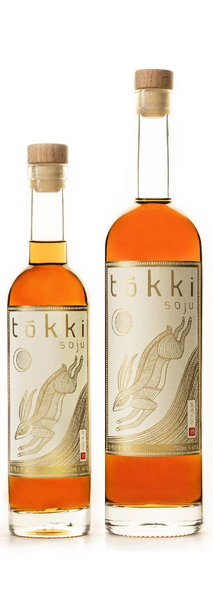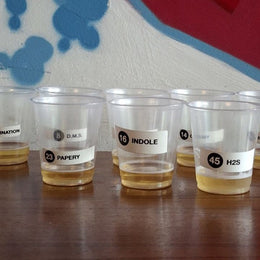Trojan Horse in a Bottle: We Learnt Why Tokki Soju is Winning Over Hearts from Brooklyn to Seoul
Imagine a sumo wrestler who does a ballet pirouette in a surprisingly graceful way. That's my impression of Tokki Soju's Black Label.

Funnily enough, 10 years from now, Koreans might find themselves reaching for a bottle of soju made by Americans, rather than Koreans. And there are a few good reasons.
Several years ago, New York restauranteurs noticed a gaping hole in the Korean spirits landscape. Upscale Japanese eateries have the famous Japanese single malts or crafty sakes, while the Chinese would have their Nixon-made-famous Moutai. Yet when high-end Michelin-starred Korean restaurants sprung up across New York, they realised that the only available “Korean traditional liquor” came in cute green bottles of mass-market soju.

Sure, they are cute… but in terms of quality and optics, mass-market soju in green bottles were never going to cut it on the top shelf next to Japanese single malts.
There were only a small handful of high-end soju brands in Korea, and supply was highly limited. The production and growth of premium soju within Korea was also slow.
This is due to archaic Korean alcohol and tax laws that counter-intuitively, favour large distillers and prevent smaller craft distilleries from operating. For instance, if you want to build a distillery in South Korea, you need to begin with 150,000 LPA in capacity before you can even get a license. These laws effectively rule out many newcomers from even beginning a craft distillery in Korea.
More on the premiumisation of soju in this story.
Taking things into their own hands, several Americans started their own brands of soju, outside Korea. Tokki Soju is one such brand that has been gaining popularity in restaurants and bars around New York and Seoul.

Founded by Brandon Hill and led by Korean-American Douglas Park, Tokki Soju was started in Brooklyn, New York. The distillery prides itself for focusing on quality over short-term profit, using high quality ingredients like high-grade glutinous rice to make their spirits.

While the typical sojus come in at around 20% ABV, Tokki produces several ranges of spirits that come in at a higher proof:
- Tokki Soju White Label (23% ABV)
- Tokki Soju Black Label (40% ABV)
- Tokki Soju Gold Label (40% ABV) – Aged in American Virgin Oak
- Sonbi Gin (48% ABV)
- Sonbi Vodka (40% ABV)
Soju is traditionally not aged in wood. But in an artistic flourish, and perhaps because Brandon was a former whiskey distiller, Tokki also produces a line of soju that is barrel-aged in oak – making it simultaneously a rice whiskey and a soju (because there are no strict rules on soju). This was stated as their way to elevate the soju category.
This month, Tokki Soju celebrates its launch in Singapore, and I had the opportunity to head down for its launch event to understand more about their production and have a taste of their tipple!


The masterclass was conducted by head distiller Brandon Hill, who recalled that he first learnt there was a demand for high-end soju in New York when a Insa Brooklyn, a modern Korean restaurant in Brooklyn approached him to create an authentic soju.

As mentioned earlier, the only soju available in New York then were mass-produced soju that were typically found in standard green bottles. High-end Korean restaurants therefore relied on wine menus to pair with their Korean food, being unwilling to pair their foods with the bright green bottles of “cheap” mass-produced soju.

Brandon then went into his production process at Tokki Soju. At the moment, Tokki Soju operates its distillery in Chungju City, Korea, where it locally sources a large amount of glutinous rice – up to 25% of all rice produced in Chungju City.
The first stage involves milling the rice to a very fine texture to give the yeast easier access to the sugars at a later stage. Next, the milled rice is then cooked in the mash tun where hydrolysis occurs to break down complex carbohydrates in the rice, and convert them into glucose (or simple sugars).

At the fermentation stage, the rice mash is fermented using Korean nuruk as the yeast starter; the enzymes in the nuruk convert the starches in the rice into sugars, which are subsequently fermented by the yeast present in the nuruk. This process happens until the mixture reaches a level of about 8.5% ABV.
The mixture is then taken for a 2-part distillation.

(Source: Tokki Soju)
Brandon earnestly impresses upon us Tokki’s signature practice of doing very narrow cuts to each run of alcohol from their stills (see above diagram). He’s referring to the process of separating the distilled liquid into different fractions – some drinkable, some undrinkable – based on their alcohol content, other chemical content and flavour profile. This process is particularly important in the production of distilled spirits such as whiskey, rum, and vodka.
According to Brandon, the majority of pot still distillers – whether whisky, rum or soju – distil their spirits and take cuts of “heads”, “hearts” and some “tails” from each round of distillation. They use about 60% to 80% of their run in their final product.
In contrast, Tokki Soju proudly states that it takes a strict cut and uses only 35% of each run in their final product, only extracting the “hearts”. This is the middle portion of the distillate, containing the smoothest ethanol, a range of desirable flavour compounds and the fewest amount of impurities or off-notes.

Finally, water is added to the distilled spirit to meet the desired ABV. As Korean water sources are filled with minerals, they are treated with a reverse osmosis process where water is filtered through a semi-permeable membrane to remove unwanted salts, particles and impurities.
Before we get too geeky, let’s check out how their products taste!

Tokki Black Label Soju, 40% ABV, Unaged

The first bottle we tasted was the Tokki Black Label Soju.
Unlike typical soju that come in at a modest 20% ABV, you can see that this bottle comes in at 40% ABV to showcase the quality of the distillate. This is intended as a full-bodied spirit that showcases the character of glutinous rice.
Appearance: Colourless.
Nose: Clean, bright, sweet and rich. Opens with a shy sweetness that hints at Sakura flowers, and develops into a distinctive yeastiness found in very expressive and sweet daiginjo sakes – a familiar charm. Toasted nuts then come into play, subtly accentuated by a thread of molasses.
Palate: Rich, sweet and very clearly glutinous rice-influenced. The journey opens with the inviting sweetness of sakes or rice (kome) shochu, with a very oily and velvety mouthfeel. Mild and creamy Thai coconut-sago dessert, a subtle warmth of spice that builds a gentle heat felt on the back palate.
Not particularly complex on the palate, but highly flavourful, textural and quite gentle on the palate.
Finish: Undeniably long, with lasting notes of sweet glutinous rice – pointing to the soju’s essence. There’s a moderate sourness that shows up – a playful twist reminiscent of Greek yoghurt that offers some balance. There’s even a slight touch of roasted sweet potatoes, adding a touch of heartiness, then a drying sensation right at the back in a final act.

My Thoughts: 🩰If your only prior reference for “soju” was those run-of-the-mill, little green bottles, this Black Label Tokki Soju is quite an eye-opener. I wouldn’t say it’s as revelatory as letting a colour-blind person see colour for the first time… but perhaps more like a sumo wrestler who suddenly does a ballet pirouette in a surprisingly graceful way.
It has a complex, rich profile, a full body and a very graceful progression with no off notes or bite. It’s like a rebellious cousin of a thick daijinjo sake or rice shochu, and almost nothing like those cutesy green bottled soju with barely any flavour of the grain used.
Tokki Gold Label Soju, 46% ABV, Aged in US Virgin Oak Barrels

The next bottle we tasted was the Tokki Gold Label Soju. This technically is more rice whiskey than soju – this had been made in exactly the same way as the Black Label, before being aged in virgin oak barrels for a little over a year.
Brandon was inspired by his past experience as an American whiskey maker when he studied the process of fermentation for rice soju, and saw many parallels with the production of corn whiskey. Both corn and rice flour contain very high levels of sugar, and respond similarly in the fermentation and aging process.
And just as many American whiskey are made, Tokki Gold is aged in a number-3 alligator char virgin American oak. The current batch had been matured in a rick house in Korea.
Appearance: Bright amber.
Nose: Sweet, rich and round. Opens with richness and warm caramelised notes that are almost chocolately, barrel-aged oakiness and a herbaceousness I sense in Maker’s Mark bourbon. Not an incredible amount of complexity here.
Palate: Round, complex with an intriguing mellowness. Once again I’m greeted by richness and a thick texture. Initially, there is this unusual mellowness that manifests as a gentle, round sensation, like a warm velvety blanket wrapping my senses.
The flavour evolve gradually, a narrative that journeys from mellow sweetness to a tasteful round oakiness. Vanilla sweeps in, deep syrup-like sweetness, like maltose in caramel. Light brine follows, a whisper of salted caramel that elegantly balances the sweetness. Over time, the flavour matures, evolving to more and more emphasis on oakiness and notes of milk chocolates.
The cleanliness of the spirit is commendable - there are no off notes, only a delightful creaminess and balanced notes.
Finish: The finish trails off with milk chocolate and vanilla. The encore comes as delightful light banana notes that leave a lasting impression.

My Thoughts: 🐴 A Trojan horse for whiskey drinkers.
This is clean, mellow, smooth as skates on a rink and well-matured by whiskey standards. I’m impressed by the smoothness and roundness of this one. Intrigued, I approached the distiller, Brandon, to discuss how he achieved this character, and we concluded that the key probably lies in the narrow cuts conducted during distillation.
This is an undeniable crowd-pleaser amongst whiskey drinkers, and serves as a cunning Trojan horse for Tokki Soju, subtly introducing their “exotic” Asian spirit to unfamiliar American consumers. I think my metaphor is fitting. This soju had been hiding in wood for some time after all – even though it wasn't expected to.
Tokki Bar in Seoul

The Tokki team then shared a little about their footprint in Seoul. In 2021, Tokki Soju opened the doors of Tokki Bar in a trendy hotel near a university in western Seoul. The bar offers Italian-American fare, as an homage to Tokki Soju's New York roots.

Operating as a speakeasy, the cocktail menu features drinks crafted with various Tokki Soju labels – whether it’s neat shots, highballs or fruit-infused mixes, each drink showcases the versatility of soju and Tokki’s potential. This is something to check out when I head to Seoul next!
Reflections on premium soju
I am pleasantly surprised by my first look at and taste of Tokki Soju. The approach these young American soju-makers have taken is pretty remarkable, weaving together time-honoured techniques from East and West and a good understanding of their consumers. The proof is in the pudding too - their soju tastes very good.

The traditional green bottles of soju still have their place in Korean culture and casual socialising, but the rise of premium soju marks an evolution in the market. And it's not just about creating a “better”product - it's about refining the perception of soju and expanding its appeal on an international stage – where top shelf drinkers crave craftsmanship and complexity.
Premium Korean soju – we are watching you. The next pour may surprise us yet again!
Geonbae!

@CharsiuCharlie







